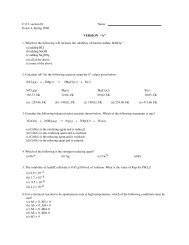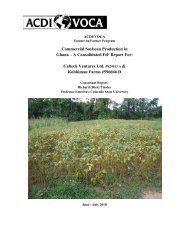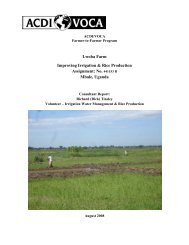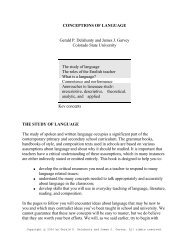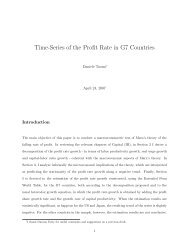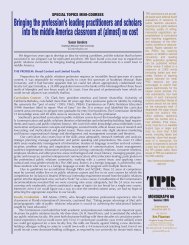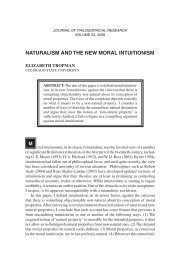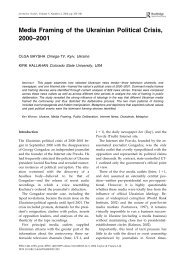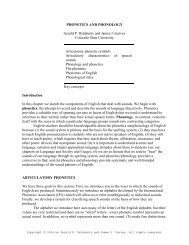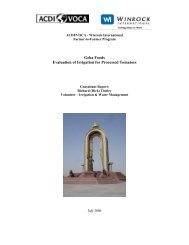Trail Log 1995-1997 - Lamar at Colorado State University
Trail Log 1995-1997 - Lamar at Colorado State University
Trail Log 1995-1997 - Lamar at Colorado State University
You also want an ePaper? Increase the reach of your titles
YUMPU automatically turns print PDFs into web optimized ePapers that Google loves.
9<br />
Bougainvillaea. Many kinds, all with three colored bracts subtending three inconspicuous flowers.<br />
Originally from Brazil, found in Rio de Janeiro by Bouganville.<br />
Hibiscus. Yellow anthers and red stamens. From China.<br />
Bird of paradise (flower). Strelitzia reginae, from South America.<br />
In the countryside about, lots of thorn trees. Fl<strong>at</strong> topped Acacia, 42 species in Kenya.<br />
July 22. Thursday.<br />
I took alone an early morning walk back down the game trail. Hartlaub's turaco (toor rah ko), seen<br />
quite nicely. This is the bird on the rear of the Collins Birds of East Africa.<br />
We left Aberdare, drove to Mt. Kenya Country Club. Thomson's gazelles. Lots of whe<strong>at</strong> fields.<br />
Reached village of Naro Moru; this is the base for climbing Mount Kenya, which is 17,058 feet in<br />
elev<strong>at</strong>ion.<br />
Went to a market on the equ<strong>at</strong>or, with so much hassle from people selling things th<strong>at</strong> it was no fun.<br />
Long-tailed widowbird, with spectacular tail. Several seen from the van. Tail is so oversized you<br />
would think it a burden in flight. But it <strong>at</strong>tracts females. When researchers glued more fe<strong>at</strong>hers to<br />
a male's tale, more females were <strong>at</strong>tracted to nests in its territory. But they jettison the tails after<br />
breeding season.<br />
We reached Mt. Kenya Safari Club about noon; this is also on the equ<strong>at</strong>or. There are birds all over<br />
the lawn and lake. Marabou storks, quite large with air sacs. Egyptian geese. Sacred Ibis; sacred<br />
in Egypt, where it is now extinct (!), but still present here. Black-headed herons. Grey herons.<br />
Hooded vulture. One exotic here: the Saras crane from India.<br />
We stayed in a r<strong>at</strong>her nice cabin some walk away from the dining hall. Servants built a fire <strong>at</strong> night.<br />
This is high enough in elev<strong>at</strong>ion to be cool <strong>at</strong> nights.<br />
Bird walk in afternoon, <strong>at</strong> 4.30. Speckled mousebird. Fiscal shrike. I couldn't trace out the origin<br />
of "fiscal" here. By one account "fiscal" went back to fisk, a public prosecutor, and was taken to<br />
mean "hangman" from the shrike's hanging lizards on thorns, though by another account the shrike<br />
has lots of lizards in the bank and is "fiscally" well off.<br />
Yellow-billed duck, on the pond.<br />
Reichnow's weaver. Yellow. Weavers are about like finches, though they have ten r<strong>at</strong>her than nine<br />
primaries. Both are seed e<strong>at</strong>ers with large bills. This is a large bird group in Africa. Finches build<br />
open nests. With weavers the male builds the nest, while the female sings. The nest is a domed<br />
structure, with an opening <strong>at</strong> the side, top, or bottom. Then the male sees whether the female likes<br />
the nest; if not he has to build another! They are colonial and acacia trees are frequent here laden<br />
with weavers' nests.<br />
Hadada ibis. Bottlebrush tree, with red hanging flowers. Wild Ipomaea, like a purple morning glory.



